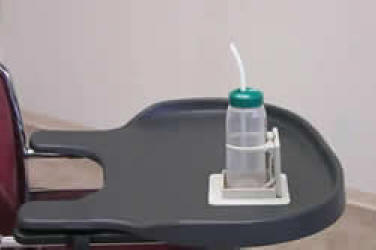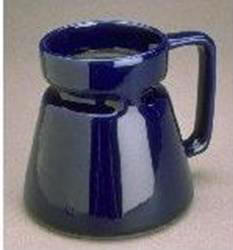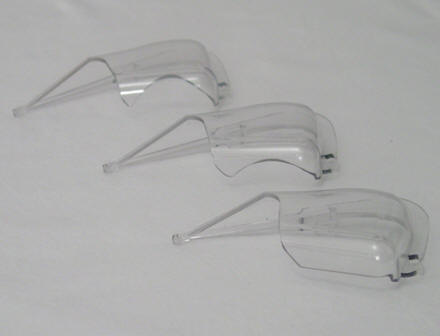Mealtime Partners, Inc.
Specializing in Assistive Dining and Drinking Equipment
September 2010 Independent Eating and Drinking Newsletter
 |
September Topics: |
||
|
Mealtime
Partners Home Page Send a Comment or Suggestion |
|||
In last months Newsletter we discussed setting goals to facilitate students gaining the ability to eat independently. This month we continue the thought process by addressing the hydration needs of students who are unable to pick up a cup or glass to provide them with a drink or take a drink from a water fountain.
Common practice in elementary schools is for students to be provided with either milk or juice in a carton or bottle at breakfast and lunch. Water, consumed by students during the day, is obtained from a water fountain. Bathroom breaks throughout the day are typically accompanied by a visit to the water fountain. A water fountain gives students a relatively small amount of liquid because when drinking from a water fountain, it is difficult to take more than a sip at a time. In high school, students are free to make their own decisions about what and when they will drink (though typically they are not allowed to drink during class). Many high schools have drink machines for students to purchase drinks. In the past, these machines contained soda. As awareness of good nutrition and the negative health impact of sugary drinks have increased, this practice has, for the most part, been discontinued. Now drink machines offer bottled water and sports drinks.
The question is: are students adequately hydrated to perform at their best when in school? In most cases the answer is no. Some schools are now recognizing this and taking action to change the situation. One school that I am aware of had a fund-raiser and used the money to buy every student a water bottle that they labeled with their name. At the beginning of each school day, students fill their bottles with water from the water fountains and keep them with them throughout the school day. They can drink whenever they want. The school Principal stated that anecdotal evidence showed that the students were calmer and performed better throughout the day. This is just an example of the potential benefits of drinking water. However, if you are unable to independently take a drink you may get very thirsty. If you are non-verbal, or have limited speech capability, the chances of under-hydration increase. Dehydration is known to foster the likelihood of bladder infections; constipation; headaches; increase spasticity; increase irritability; reduce the ability to concentrate, etc. Therefore, students with disabilities may be less able to apply themselves in school simply because they are under hydrated.
As with the students who were given water bottles, it is desirable to make water constantly available to students who are unable to take a drink independently. This is easily done for students who are able to drink through a straw. It is not so easy for those who cannot suck. In next months Newsletter, information will be provided on how to possibly meet the hydration needs of this special group of students; however, this month we will focus on drinking using a straw.
For students who have good upper body control it is easy to put a cup with a lid on it and straw through the lid, on a desk or the laptray of a wheelchair. The student can simply lean forward and sip from the straw. If, however, the student has some involuntary movement, the cup will need to be stabilized so that it won’t get knocked over. This can be accomplished by placing the cup in a cup holder, or by using a wide bottomed travel mug that is placed on a piece of Dycem. Also, some mugs with a non-slip bottom are available for purchase. Coffee mugs often have a tab that opens and closes to stop the liquid spilling. These are useful to hold straws at the desired angle for the user. Insert the straw into the hole and then gently snug the tab up against the straw to hold it in place.
 |
 |
| Cup Holder on Laptray | Wide-Bottomed Travel Mug |
For students who have a limited range of voluntary movement and who are unable to freely move toward and/or away from a straw, a drinking system that can be mounted appropriately for their needs should be used. Things that should be considered when selecting a drinking system are: the user’s ability to suck; the strength of their suction; their ability to move to a straw (the distance that the end of the straw needs to be away from their lips). Mealtime Partners, Inc. has developed several unique drinking systems to meet the specialized needs of individuals who have difficulties drinking independently from a traditional cup or glass. For more information about the available drinking systems, click here. For each drinking system available from Mealtime Partners, Inc., you will find a description of the unique characteristics of each system and the profile of users who would benefit from using them.
Hopefully you have taken note that throughout this article the intake of water has been discussed. Even if a student has a low caloric intake, and efforts are being made to increase it, making water available between meals is encouraged for proper hydration. The only exception to this rule is for those who must only consume thickened liquids. Thickening products change the taste and feel of drinks, and water often does not taste “right” when thickened. For those students, cranberry juice, diluted lemon juice or lemonade is recommended as it will help mask the taste of the thickening product.
| Did You Know? ... Did you know that if you are fed by another person you are less likely to talk with your mealtime companions than if you feed yourself? Once the reason for this is understood, it becomes obvious: if you are not sure when food will be put into your mouth, you must concentrate on the person feeding you and their actions. It is hard to talk and not be afraid that you will have food put in your mouth while you are talking. For regular feeding partners it is recommended that a “code” is developed between the person being fed and the person feeding them. A slight head gesture, or some other sign, can indicate that the person is ready for the next bite of food. The risk of putting food into someone's mouth before they are ready is therefore reduced and conversation can be normalized. |
| The Mealtime Partner Dining System
allows each user to have a unique dining experience. The Mealtime Partner Bowl Covers customize meals for each individual. They permit each spoonful of food offered to the user, to be of the volume to meet their likes and needs. Simply snap the desired size of bowl cover onto each bowl and the food on the spoon is adjusted accordingly. This is just one of the many features that make the Mealtime Partner Dining System extraordinary. For those who are unable to feed themselves, the Mealtime Partner Dining System is the best possible way for gaining mealtime independence. |
 |
Food Likes and Dislikes
We all have likes and dislikes in foods. For some people it is the texture of certain foods that they find objectionable; for others, it is the taste. As babies grow into children they establish their own set of preferences and often go through stages of vigorously rejecting certain foods. Food is pushed off the plate or even thrown because they don’t want it anywhere near them. However, for children with severe disabilities who have always been fed, this cannot occur in the way that eating normally evolves for children. So how do these children express likes and dislikes? Often their reaction is to spit (or push) the food out of their mouth. This raises a question that must be considered: how do you reject food if you don’t have the oral motor abilities to spit or push the food out of your mouth with your tongue? This particular group of children must develop some other way of expressing that they dislike certain foods. If they don’t, they will have to eat whatever is given to them. More commonly, they stop eating, or cry and get very upset, or both. It is often difficult for the person feeding a child to know exactly why they are not eating. And, once a child is upset, it is hard to continue the meal.
How does the feeding partner determine the cause of the upset? First, the feeding partner should consider all of the obvious reasons for the child being upset: are they uncomfortable, or in pain; do they need changing or to go to the bathroom; are they not hungry; are they thirsty; etc? However, once the obvious causes for distress have been eliminated, dislike of a certain food should be considered. It should always be remembered that tastes change and mature and possibly something that was being eaten and enjoyed when they were younger might be rejected at a later time. Always have at least two food choices available and offer the alternate if the child demonstrates that they are getting upset when one is offered. If the child settles and is happy to eat the alternate, do not try to “trick” them into eating the rejected food. Wait a week or two and try offering it again. If it is rejected on that occasion, it is most probably food that they don’t like. As the child gets older it is fine to expect them to taste anything. However, if they find it objectionable they shouldn’t be expected to eat a large quantity of it. Also, do not mix the food with a food that the child likes. Firstly, it may confuse them that something that they like tastes different and possibly horrible. Secondly, it might cause them to reject the food that they actually like. And, lastly, the child might reduce their intake of food because nothing tastes good to them.
Respect children’s right to not eat every type of food. Nobody likes everything! As they grow up, if a wide variety of foods are offered to them for them to try they will learn to eat an assortment of flavors.
It should be noted that for children who have food aversions, the above information is not necessarily helpful. For advice on feeding children with food aversions, please consult a feeding clinic. Many major hospitals in metropolitan areas have feeding clinics. Or, consult a speech pathologist specializing in this area.
Once it is established that a child doesn’t like a specific food do not reintroduce it to them for several months. Give their taste buds time to mature, and then try again. Be willing to accept that they simply don’t like something. Remember, it is more important for a child to enjoy their meals than for each meal to become a battle to make them eat. The stress created by this type of situation hurts the relationship and makes meals a time to be dreaded, not enjoyed. Bear in mind, if a child is being fed, the meal is a partnership. If one of the partners is stressed, the other will sense the stress and often become stressed themselves.
Happy eating! Tip of the Month: If you are
in a slightly reclined position your body and mind do not
“think” actively. They are in a resting state. To be alert and
ready to eat, the shoulders should be forward over the pelvis.
This will signal the body that an action is going to happen. The
ready-to-eat position aligns the head, neck and digestive track
in the most advantageous position to eat, chew and swallow. It
is also considerably safer than eating in a reclining position.
Mealtime Partners Website Navigation:
Home | Dining | Drinking | Videos | Products | Warranty | Ordering | Calendar | FAQ | Newsletters | Contact
Please send comments and suggestions to newsletters@mealtimepartners.com
Copyright © Mealtime Partners, Inc. 2010
All rights reserved.